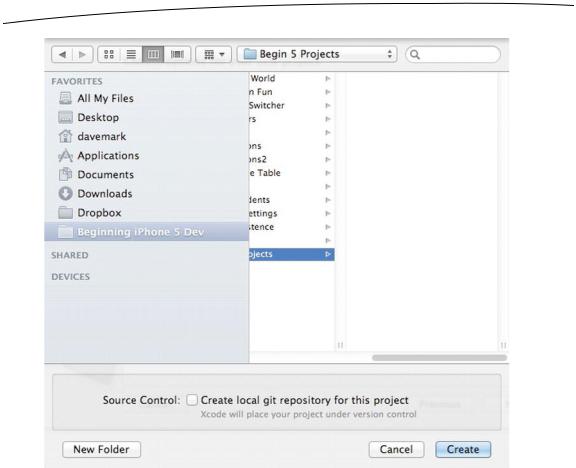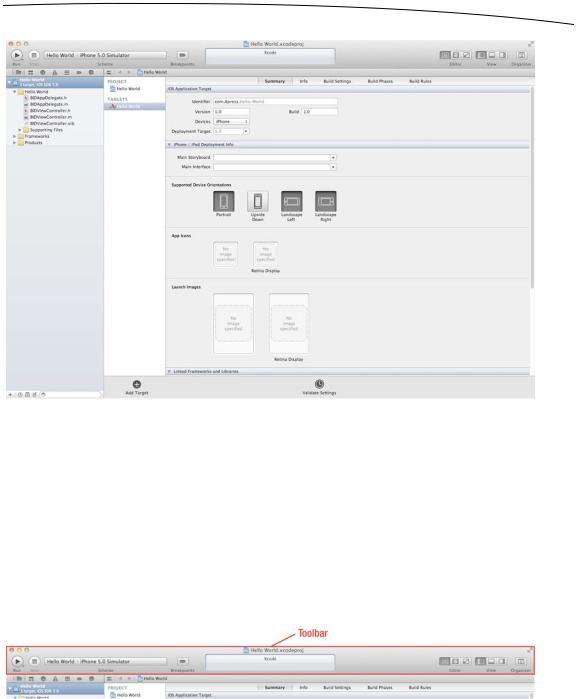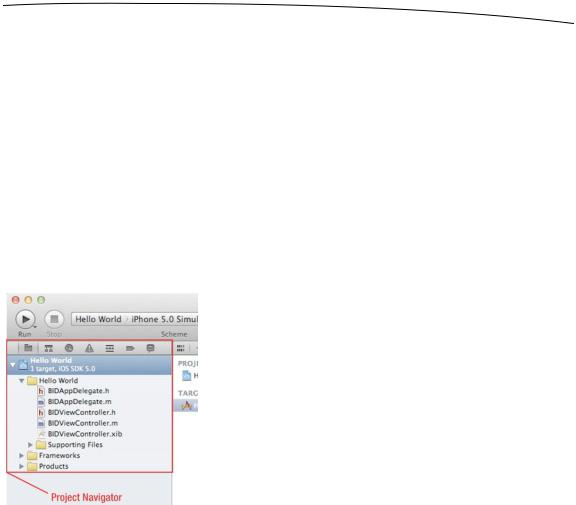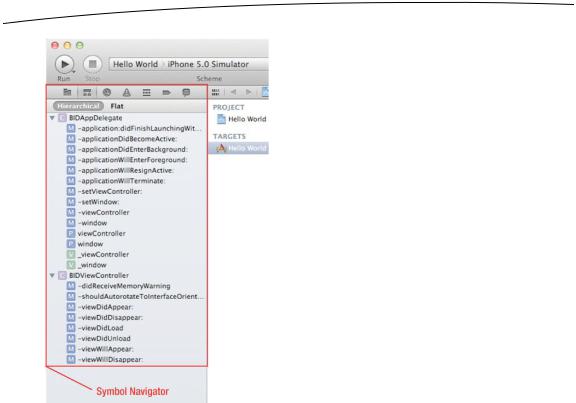
- •Contents at a Glance
- •About the Authors
- •About the Technical Reviewer
- •Acknowledgments
- •Preface
- •What This Book Is
- •What You Need
- •Developer Options
- •What You Need to Know
- •What’s Different About Coding for iOS?
- •Only One Active Application
- •Only One Window
- •Limited Access
- •Limited Response Time
- •Limited Screen Size
- •Limited System Resources
- •No Garbage Collection, but…
- •Some New Stuff
- •A Different Approach
- •What’s in This Book
- •What’s New in This Update?
- •Are You Ready?
- •Setting Up Your Project in Xcode
- •The Xcode Workspace Window
- •The Toolbar
- •The Navigator View
- •The Jump Bar
- •The Utility Pane
- •Interface Builder
- •New Compiler and Debugger
- •A Closer Look at Our Project
- •Introducing Xcode’s Interface Builder
- •What’s in the Nib File?
- •The Library
- •Adding a Label to the View
- •Changing Attributes
- •Some iPhone Polish—Finishing Touches
- •Bring It on Home
- •The Model-View-Controller Paradigm
- •Creating Our Project
- •Looking at the View Controller
- •Understanding Outlets and Actions
- •Outlets
- •Actions
- •Cleaning Up the View Controller
- •Designing the User Interface
- •Adding the Buttons and Action Method
- •Adding the Label and Outlet
- •Writing the Action Method
- •Trying It Out
- •Looking at the Application Delegate
- •Bring It on Home
- •A Screen Full of Controls
- •Active, Static, and Passive Controls
- •Creating the Application
- •Implementing the Image View and Text Fields
- •Adding the Image View
- •Resizing the Image View
- •Setting View Attributes
- •The Mode Attribute
- •Interaction Checkboxes
- •The Alpha Value
- •Background
- •Drawing Checkboxes
- •Stretching
- •Adding the Text Fields
- •Text Field Inspector Settings
- •Setting the Attributes for the Second Text Field
- •Creating and Connecting Outlets
- •Closing the Keyboard
- •Closing the Keyboard When Done Is Tapped
- •Touching the Background to Close the Keyboard
- •Adding the Slider and Label
- •Creating and Connecting the Actions and Outlets
- •Implementing the Action Method
- •Adding Two Labeled Switches
- •Connecting and Creating Outlets and Actions
- •Implementing the Switch Actions
- •Adding the Button
- •Connecting and Creating the Button Outlets and Actions
- •Implementing the Segmented Control Action
- •Implementing the Action Sheet and Alert
- •Conforming to the Action Sheet Delegate Method
- •Showing the Action Sheet
- •Spiffing Up the Button
- •Using the viewDidLoad Method
- •Control States
- •Stretchable Images
- •Crossing the Finish Line
- •The Mechanics of Autorotation
- •Points, Pixels, and the Retina Display
- •Autorotation Approaches
- •Handling Rotation Using Autosize Attributes
- •Configuring Supported Orientations
- •Specifying Rotation Support
- •Designing an Interface with Autosize Attributes
- •Using the Size Inspector’s Autosize Attributes
- •Setting the Buttons’ Autosize Attributes
- •Restructuring a View When Rotated
- •Creating and Connecting Outlets
- •Moving the Buttons on Rotation
- •Swapping Views
- •Designing the Two Views
- •Implementing the Swap
- •Changing Outlet Collections
- •Rotating Out of Here
- •Common Types of Multiview Apps
- •The Architecture of a Multiview Application
- •The Root Controller
- •Anatomy of a Content View
- •Building View Switcher
- •Creating Our View Controller and Nib Files
- •Modifying the App Delegate
- •Modifying BIDSwitchViewController.h
- •Adding a View Controller
- •Building a View with a Toolbar
- •Writing the Root View Controller
- •Implementing the Content Views
- •Animating the Transition
- •Switching Off
- •The Pickers Application
- •Delegates and Data Sources
- •Setting Up the Tab Bar Framework
- •Creating the Files
- •Adding the Root View Controller
- •Creating TabBarController.xib
- •The Initial Test Run
- •Implementing the Date Picker
- •Implementing the Single-Component Picker
- •Declaring Outlets and Actions
- •Building the View
- •Implementing the Controller As a Data Source and Delegate
- •Implementing a Multicomponent Picker
- •Declaring Outlets and Actions
- •Building the View
- •Implementing the Controller
- •Implementing Dependent Components
- •Creating a Simple Game with a Custom Picker
- •Writing the Controller Header File
- •Building the View
- •Adding Image Resources
- •Implementing the Controller
- •The spin Method
- •The viewDidLoad Method
- •Final Details
- •Linking in the Audio Toolbox Framework
- •Final Spin
- •Table View Basics
- •Table Views and Table View Cells
- •Grouped and Plain Tables
- •Implementing a Simple Table
- •Designing the View
- •Writing the Controller
- •Adding an Image
- •Using Table View Cell Styles
- •Setting the Indent Level
- •Handling Row Selection
- •Changing the Font Size and Row Height
- •Customizing Table View Cells
- •Adding Subviews to the Table View Cell
- •Creating a UITableViewCell Subclass
- •Adding New Cells
- •Implementing the Controller’s Code
- •Loading a UITableViewCell from a Nib
- •Designing the Table View Cell in Interface Builder
- •Using the New Table View Cell
- •Grouped and Indexed Sections
- •Building the View
- •Importing the Data
- •Implementing the Controller
- •Adding an Index
- •Implementing a Search Bar
- •Rethinking the Design
- •A Deep Mutable Copy
- •Updating the Controller Header File
- •Modifying the View
- •Modifying the Controller Implementation
- •Copying Data from allNames
- •Implementing the Search
- •Changes to viewDidLoad
- •Changes to Data Source Methods
- •Adding a Table View Delegate Method
- •Adding Search Bar Delegate Methods
- •Adding a Magnifying Glass to the Index
- •Adding the Special Value to the Keys Array
- •Suppressing the Section Header
- •Telling the Table View What to Do
- •Putting It All on the Table
- •Navigation Controller Basics
- •Stacky Goodness
- •A Stack of Controllers
- •Nav, a Hierarchical Application in Six Parts
- •Meet the Subcontrollers
- •The Disclosure Button View
- •The Checklist View
- •The Rows Control View
- •The Movable Rows View
- •The Deletable Rows View
- •The Editable Detail View
- •The Nav Application’s Skeleton
- •Creating the Top-Level View Controller
- •Setting Up the Navigation Controller
- •Adding the Images to the Project
- •First Subcontroller: The Disclosure Button View
- •Creating the Detail View
- •Modifying the Disclosure Button Controller
- •Adding a Disclosure Button Controller Instance
- •Second Subcontroller: The Checklist
- •Creating the Checklist View
- •Adding a Checklist Controller Instance
- •Third Subcontroller: Controls on Table Rows
- •Creating the Row Controls View
- •Adding a Rows Control Controller Instance
- •Fourth Subcontroller: Movable Rows
- •Creating the Movable Row View
- •Adding a Move Me Controller Instance
- •Fifth Subcontroller: Deletable Rows
- •Creating the Deletable Rows View
- •Adding a Delete Me Controller Instance
- •Sixth Subcontroller: An Editable Detail Pane
- •Creating the Data Model Object
- •Creating the Detail View List Controller
- •Creating the Detail View Controller
- •Adding an Editable Detail View Controller Instance
- •But There’s One More Thing. . .
- •Breaking the Tape
- •Creating a Simple Storyboard
- •Dynamic Prototype Cells
- •Dynamic Table Content, Storyboard-Style
- •Editing Prototype Cells
- •Good Old Table View Data Source
- •Will It Load?
- •Static Cells
- •Going Static
- •So Long, Good Old Table View Data Source
- •You Say Segue, I Say Segue
- •Creating Segue Navigator
- •Filling the Blank Slate
- •First Transition
- •A Slightly More Useful Task List
- •Viewing Task Details
- •Make More Segues, Please
- •Passing a Task from the List
- •Handling Task Details
- •Passing Back Details
- •Making the List Receive the Details
- •If Only We Could End with a Smooth Transition
- •Split Views and Popovers
- •Creating a SplitView Project
- •The Storyboard Defines the Structure
- •The Code Defines the Functionality
- •The App Delegate
- •The Master View Controller
- •The Detail View Controller
- •Here Come the Presidents
- •Creating Your Own Popover
- •iPad Wrap-Up
- •Getting to Know Your Settings Bundle
- •The AppSettings Application
- •Creating the Project
- •Working with the Settings Bundle
- •Adding a Settings Bundle to Our Project
- •Setting Up the Property List
- •Adding a Text Field Setting
- •Adding an Application Icon
- •Adding a Secure Text Field Setting
- •Adding a Multivalue Field
- •Adding a Toggle Switch Setting
- •Adding the Slider Setting
- •Adding Icons to the Settings Bundle
- •Adding a Child Settings View
- •Reading Settings in Our Application
- •Retrieving User Settings
- •Creating the Main View
- •Updating the Main View Controller
- •Registering Default Values
- •Changing Defaults from Our Application
- •Keeping It Real
- •Beam Me Up, Scotty
- •Your Application’s Sandbox
- •Getting the Documents Directory
- •Getting the tmp Directory
- •File-Saving Strategies
- •Single-File Persistence
- •Multiple-File Persistence
- •Using Property Lists
- •Property List Serialization
- •The First Version of the Persistence Application
- •Creating the Persistence Project
- •Designing the Persistence Application View
- •Editing the Persistence Classes
- •Archiving Model Objects
- •Conforming to NSCoding
- •Implementing NSCopying
- •Archiving and Unarchiving Data Objects
- •The Archiving Application
- •Implementing the BIDFourLines Class
- •Implementing the BIDViewController Class
- •Using iOS’s Embedded SQLite3
- •Creating or Opening the Database
- •Using Bind Variables
- •The SQLite3 Application
- •Linking to the SQLite3 Library
- •Modifying the Persistence View Controller
- •Using Core Data
- •Entities and Managed Objects
- •Key-Value Coding
- •Putting It All in Context
- •Creating New Managed Objects
- •Retrieving Managed Objects
- •The Core Data Application
- •Designing the Data Model
- •Creating the Persistence View and Controller
- •Persistence Rewarded
- •Managing Document Storage with UIDocument
- •Building TinyPix
- •Creating BIDTinyPixDocument
- •Code Master
- •Initial Storyboarding
- •Creating BIDTinyPixView
- •Storyboard Detailing
- •Adding iCloud Support
- •Creating a Provisioning Profile
- •Enabling iCloud Entitlements
- •How to Query
- •Save Where?
- •Storing Preferences on iCloud
- •What We Didn’t Cover
- •Grand Central Dispatch
- •Introducing SlowWorker
- •Threading Basics
- •Units of Work
- •GCD: Low-Level Queueing
- •Becoming a Blockhead
- •Improving SlowWorker
- •Don’t Forget That Main Thread
- •Giving Some Feedback
- •Concurrent Blocks
- •Background Processing
- •Application Life Cycle
- •State-Change Notifications
- •Creating State Lab
- •Exploring Execution States
- •Making Use of Execution State Changes
- •Handling the Inactive State
- •Handling the Background State
- •Removing Resources When Entering the Background
- •Saving State When Entering the Background
- •A Brief Journey to Yesteryear
- •Back to the Background
- •Requesting More Backgrounding Time
- •Grand Central Dispatch, Over and Out
- •Two Views of a Graphical World
- •The Quartz 2D Approach to Drawing
- •Quartz 2D’s Graphics Contexts
- •The Coordinate System
- •Specifying Colors
- •A Bit of Color Theory for Your iOS Device’s Display
- •Other Color Models
- •Color Convenience Methods
- •Drawing Images in Context
- •Drawing Shapes: Polygons, Lines, and Curves
- •The QuartzFun Application
- •Setting Up the QuartzFun Application
- •Creating a Random Color
- •Defining Application Constants
- •Implementing the QuartzFunView Skeleton
- •Creating and Connecting Outlets and Actions
- •Implementing the Action Methods
- •Adding Quartz 2D Drawing Code
- •Drawing the Line
- •Drawing the Rectangle and Ellipse
- •Drawing the Image
- •Optimizing the QuartzFun Application
- •The GLFun Application
- •Setting Up the GLFun Application
- •Creating BIDGLFunView
- •Updating BIDViewController
- •Updating the Nib
- •Finishing GLFun
- •Drawing to a Close
- •Multitouch Terminology
- •The Responder Chain
- •Responding to Events
- •Forwarding an Event: Keeping the Responder Chain Alive
- •The Multitouch Architecture
- •The Four Touch Notification Methods
- •The TouchExplorer Application
- •The Swipes Application
- •Automatic Gesture Recognition
- •Implementing Multiple Swipes
- •Detecting Multiple Taps
- •Detecting Pinches
- •Defining Custom Gestures
- •The CheckPlease Application
- •The CheckPlease Touch Methods
- •Garçon? Check, Please!
- •The Location Manager
- •Setting the Desired Accuracy
- •Setting the Distance Filter
- •Starting the Location Manager
- •Using the Location Manager Wisely
- •The Location Manager Delegate
- •Getting Location Updates
- •Getting Latitude and Longitude Using CLLocation
- •Error Notifications
- •Trying Out Core Location
- •Updating Location Manager
- •Determining Distance Traveled
- •Wherever You Go, There You Are
- •Accelerometer Physics
- •Don’t Forget Rotation
- •Core Motion and the Motion Manager
- •Event-Based Motion
- •Proactive Motion Access
- •Accelerometer Results
- •Detecting Shakes
- •Baked-In Shaking
- •Shake and Break
- •Accelerometer As Directional Controller
- •Rolling Marbles
- •Writing the Ball View
- •Calculating Ball Movement
- •Rolling On
- •Using the Image Picker and UIImagePickerController
- •Implementing the Image Picker Controller Delegate
- •Road Testing the Camera and Library
- •Designing the Interface
- •Implementing the Camera View Controller
- •It’s a Snap!
- •Localization Architecture
- •Strings Files
- •What’s in a Strings File?
- •The Localized String Macro
- •Real-World iOS: Localizing Your Application
- •Setting Up LocalizeMe
- •Trying Out LocalizeMe
- •Localizing the Nib
- •Localizing an Image
- •Generating and Localizing a Strings File
- •Localizing the App Display Name
- •Auf Wiedersehen
- •Apple’s Documentation
- •Mailing Lists
- •Discussion Forums
- •Web Sites
- •Blogs
- •Conferences
- •Follow the Authors
- •Farewell
- •Index

18 |
CHAPTER 2: Appeasing the Tiki Gods |
Figure 2–4. Saving your project in a project folder on your hard drive
The Xcode Workspace Window
After you dismiss the save sheet, Xcode will create and then open your project. You will see a new workspace window, as shown in Figure 2–5. There’s a lot of information crammed into this window, and it’s where you will be spending a lot of your iOS development time.
www.it-ebooks.info

CHAPTER 2: Appeasing the Tiki Gods |
19 |
Figure 2–5. The Hello World project in Xcode
Even if you are an old hand with earlier versions of Xcode, you’ll still benefit from reading through this section, as a lot has changed since the last release of Xcode 3.x. Let’s take a quick tour.
The Toolbar
The top of the Xcode workspace window is called the toolbar (see Figure 2–6). On the left side of the toolbar are controls to start and stop running your project, a popup menu to select the scheme you want to run, and a button to toggle breakpoints on and off. A scheme brings together target and build settings, and the toolbar popup menu lets you select a specific setup with just one click.
Figure 2–6. The Xcode toolbar
The big box in the middle of the toolbar is the activity view. As its name implies, the activity view displays any actions or processes that are currently happening. For
www.it-ebooks.info

20 |
CHAPTER 2: Appeasing the Tiki Gods |
example, when you run your project, the activity view gives you a running commentary on the various steps it’s taking to build your application. If you encounter any errors or warnings, that information is displayed here as well. If you click the warning or error, you’ll go directly to the issues navigator, which provides more information about the warning or error, as described in the next section.
On the right side of the toolbar are three sets of buttons. The left set, labeled Editor, lets you switch between three different editor configurations:
The standard view gives you a single pane dedicated to editing a file or project-specific configuration values.
The incredibly powerful assistant view splits the editor pane into two panes, left and right. The pane on the right is generally used to display a file that relates to the file on the left, or that you might need to refer to while editing the file on the left. You can manually specify what goes into each pane, or you can let Xcode decide what’s most appropriate for the task at hand. For example, if you’re editing the implementation of an Objective-C class (the .m file), Xcode will automatically show you that class’s header file (the .h file) in the right pane. If you’re designing your user interface on the left, Xcode will show you the code that user interface is able to interact with on the right. You’ll see the assistant view at work throughout the book.
The versions button converts the editor pane into a time-machine-like comparison view that works with source code management systems such as Subversion and Git. You can compare the current version of a source file with a previously committed version or compare any two earlier versions with each other.
To the right of the editor button set is another set of buttons that show and hide the navigator pane and the utility pane, on the left and right side of the editor pane. Click those buttons to see these panes in action.
Finally, the rightmost button brings up the Organizer window, which is where you’ll find the bulk of nonproject-specific functionality. It’s used as the documentation viewer for Apple’s API documentation, shows you all the source code repositories that Xcode knows about, keeps a list of all projects you’ve opened, and maintains a list of all devices that you’ve synchronized with this computer.
www.it-ebooks.info

CHAPTER 2: Appeasing the Tiki Gods |
21 |
The Navigator View
Just below the toolbar, on the left side of the workspace window, is the navigator view. The navigator view offers seven configurations that give you different views into your project. Click one of the icons at the top of the navigator view to switch among the following navigators, going from left to right:
Project navigator: This view contains a list of files that are used by your project (see Figure 2–7). You can store references to everything you expect—from source code files to artwork, data models, property list (or plist) files (discussed in the “A Closer Look at Our Project” section later in this chapter), and even other project files. By storing multiple projects in a single workspace, multiple projects can easily share resources. If you click any file in the navigator view, that file will display in the editor pane. In addition to viewing the file, you can also edit the file (if it’s a file that Xcode knows how to edit).
Figure 2–7. The Xcode navigator view showing the project navigator. Click one of the seven icons at the top of the view to switch navigators.
Symbol navigator: As its name implies, this navigator focuses on the symbols defined in the workspace (see Figure 2–8). Symbols are basically the items that the compiler recognizes, such as Objective-C classes, enumerations, structs, and global variables.
www.it-ebooks.info

22 |
CHAPTER 2: Appeasing the Tiki Gods |
Figure 2–8. The Xcode navigator view showing the symbol navigator. Open the disclosure triangle to explore the files and symbols defined within each group.
Search navigator: You’ll use this navigator to perform searches on all the files in your workspace (see Figure 2–9). You can select Replace from the Find popup menu, and do a search and replace on all or just selected portions of the search results. For richer searches, select Show Find Options from the popup menu tied to the magnifying glass in the search field.
www.it-ebooks.info

CHAPTER 2: Appeasing the Tiki Gods |
23 |
Figure 2–9. The Xcode navigator view showing the search navigator. Be sure to check out the popup menus hidden under the word Find and under the magnifying glass in the search field.
Issues navigator: When you build your project, any errors or warnings will appear in this navigator, and a message detailing the number of errors will appear in the activity view at the top of the window (see Figure 2–10). When you click an error in the issues navigator, you’ll jump to the appropriate line of code in the editor pane.
Figure 2–10. The Xcode navigator view showing the issues navigator. This is where you’ll find your compiler errors and warnings.
Debug navigator: This navigator is your main view into the debugging process (see Figure 2–11). If you are new to debugging, you might check out this part of the Xcode 4 User Guide:
http://developer.apple.com/library/mac/#documentation/
ToolsLanguages/Conceptual/Xcode4UserGuide/Debugging/Debugging.html
www.it-ebooks.info

24 |
CHAPTER 2: Appeasing the Tiki Gods |
The debug navigator lists the stack frame for each active thread. A stack frame is a list of the functions or methods that have been called previously, in the order they were called. Click a method, and the associated code appears in the editor pane. In the editor, there will be a second frame, where you can control the debugging process, display and modify data values, and access the low-level debugger. A slider at the bottom of the debug navigator allows you to control the level of detail it tracks. Slide to the extreme right to see everything, including all the system calls. Slide to the extreme left to see only your calls. The default setting of right in the middle is a good place to start.
Figure 2–11. The Xcode navigator view showing the debug navigator. Be sure to try out the detail slider at the bottom of the window, which allows you to specify the level of debug detail you want to see.
Breakpoint navigator: The breakpoint navigator lets you see all the breakpoints that you’ve set (see Figure 2–12). Breakpoints are, as the name suggests, points in your code where the application will stop running (or break), so that you can look at the values in variables and do other tasks needed to debug your application. The list of breakpoints in this navigator is organized by file. Click a breakpoint in the list, and that line will appear in the editor pane. Be sure to check out the popup at the lower-left corner of the workspace window when in the breakpoint navigator. The plus popup lets you add an exception or symbolic breakpoint, and the minus popup deletes any selected breakpoints.
www.it-ebooks.info
